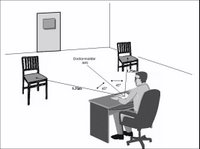 Patients suffering from depression or anxiety are more likely to choose to sit to their left when visiting the GP, an observation that has implications for the detection of psychological distress among patients. That’s according to a study by Dr. Peter Luck, at Christmas Maltings Surgery in Suffolk.
Patients suffering from depression or anxiety are more likely to choose to sit to their left when visiting the GP, an observation that has implications for the detection of psychological distress among patients. That’s according to a study by Dr. Peter Luck, at Christmas Maltings Surgery in Suffolk.“The seating arrangement I now use in my surgery allows patients to choose their spatial orientation (left/right) with me during face-to-face consultations. I use this system to alert me, when patients choose to sit to their left, that there is a greater possibility that they may be suffering from psychological distress “, Dr. Luck told the Digest.
During Luck’s research, a GP’s consulting room was arranged for five months so that two chairs were positioned an equal distance to the left or right of the GP’s desk. The choice of chair made by 756 patients seeing their GP was recorded, and after their consultation each patient was tested for anxiety and depression using the Hospital Anxiety and Depression Scale. Their handedness was determined according to the hand they wrote with.
Among the 674 right-handed patients, Dr. Luck found that those who scored positively for anxiety or depression (358 of them) were significantly more likely to sit in the left-hand chair facing the GP (59 per cent of them did) than those who weren’t anxious or depressed (27 per cent of them sat on the left). A similar effect was not found among the 82 left-handers, possibly because they were too few in number.
The right-handed patients who weren’t depressed or anxious tended to choose the right-hand chair, reflecting their attentional preference for the left side of space, consistent with past research. Somehow, psychological distress seems to affect this usual attentional bias, thus explaining the Dr. Luck’s pattern of results. The finding adds to past research showing that depressed mothers tend to cradle their baby on their right, the opposite of the usual bias among mothers to hold their baby on the left (see Digest issue 26, item 1).
__________________________________
Luck, P. (2006). Does the presence of psychological distress in patients influence their choice of sitting position in face-to-face consultation with the GP? Laterality, 11, 90-100.
You have read this article Mental health
with the title Detecting psychological distress from where a patient sits. You can bookmark this page URL https://psychiatryfun.blogspot.com/2006/02/detecting-psychological-distress-from.html. Thanks!





No comment for "Detecting psychological distress from where a patient sits"
Post a Comment